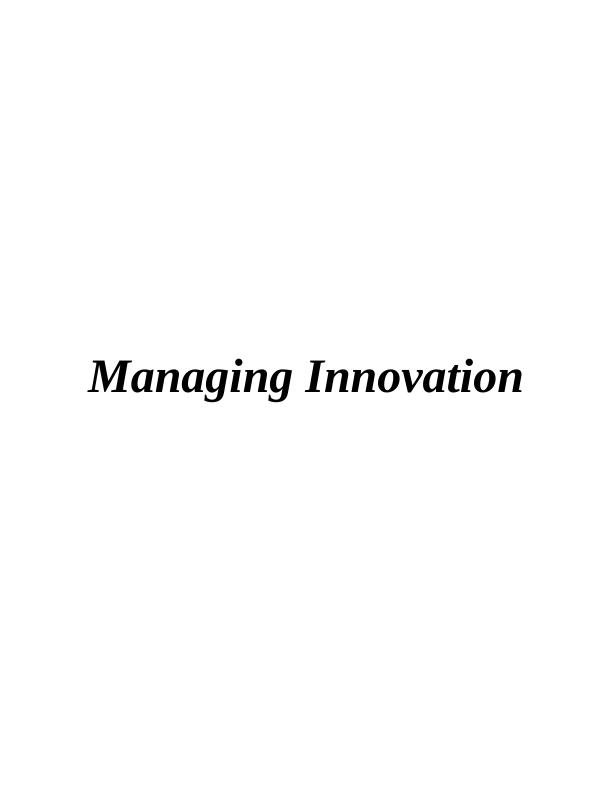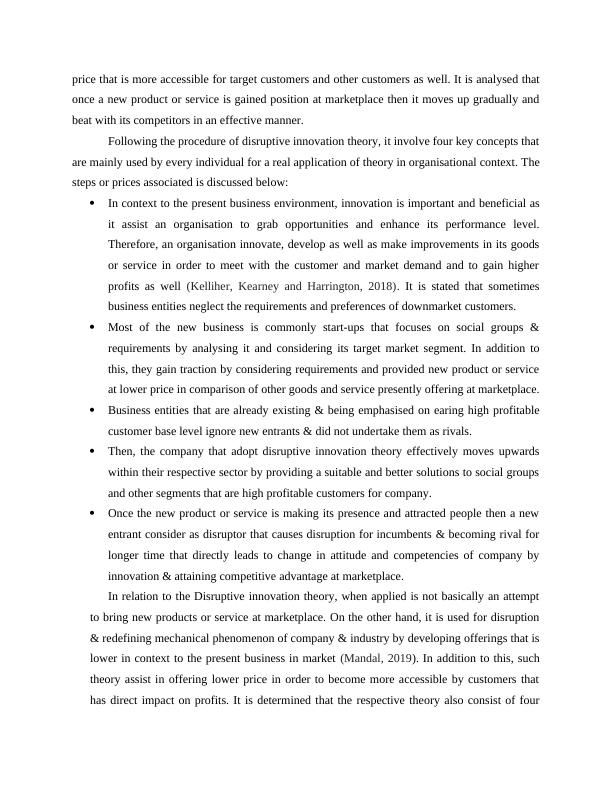Managing Innovation
Added on 2023-01-06
14 Pages3679 Words94 Views
Managing Innovation

Table of Contents
INTRODUCTION...........................................................................................................................3
MAIN BODY...................................................................................................................................3
Disruptive Innovation Theory................................................................................................3
Application of the Disruptive Innovation Theory in the historical development context......7
Application of the Disruptive Innovation Theory in the future development context.........10
CONCLUSION..............................................................................................................................11
REFERENCES..............................................................................................................................13
INTRODUCTION...........................................................................................................................3
MAIN BODY...................................................................................................................................3
Disruptive Innovation Theory................................................................................................3
Application of the Disruptive Innovation Theory in the historical development context......7
Application of the Disruptive Innovation Theory in the future development context.........10
CONCLUSION..............................................................................................................................11
REFERENCES..............................................................................................................................13

INTRODUCTION
Innovation is defined as a process of implementation of a new or significantly changes
goods and processes. In addition to this, it is a new idea, plan or a method that an organisation
adopt in order to bring some innovation in market that customers are looking for (Biemans,
2018). It is basically an idea to add value for customer and satisfy them with innovative product
as well as services. In context to innovation management, it is the process which involve
developing awareness of new idea within a company & in external environment with a view to
enhance efficiency of innovative goods and services. For the present report, Spotify is taken into
consideration. It is a Swedish audio streaming & media service provider that was established in
year 2008 and its head office is located in Stockholm. The main motive of the company is to
offer unique as well as best platform to its user in order to stream their interest of music, audio
media, podcasts and so on. The report will cover disruptive innovation theory along with its
benefits & limitations as well. In addition to this, respective theory is applied for historical
development & future development in relation to Spotify.
MAIN BODY
Disruptive Innovation Theory
Disruptive Innovation is defined as a procedure by which goods or service initially
takes roots within simple applications that is less expensive as well as more accessible. In
addition to this, it is basically a way of bringing product at marketplace and enhance its presence.
It shows the concern for existing businesses and companies in market that is caused because if
new entrants at marketplace In the present business environment, the way of doing business is
change and shift towards bringing creativity and innovation that has arisen number of start-ups
which emerges or enter in market with an objective to change the way offering of industry by
providing substitute of existing product or by considering an unattended requirement of social
groups.
Hence, disruptive innovation theory revolves with the concept of how a business entity
either existing or new entrants can develop an alliance in order to understand the present
opportunities as well as threats for gaining out potential & how it become more adding value to
customer requirements and objectives attainment of a company (Mousavi, Bossink and van Vliet,
2018). This theory is basically a procedure of initially presenting goods and services at minimum
Innovation is defined as a process of implementation of a new or significantly changes
goods and processes. In addition to this, it is a new idea, plan or a method that an organisation
adopt in order to bring some innovation in market that customers are looking for (Biemans,
2018). It is basically an idea to add value for customer and satisfy them with innovative product
as well as services. In context to innovation management, it is the process which involve
developing awareness of new idea within a company & in external environment with a view to
enhance efficiency of innovative goods and services. For the present report, Spotify is taken into
consideration. It is a Swedish audio streaming & media service provider that was established in
year 2008 and its head office is located in Stockholm. The main motive of the company is to
offer unique as well as best platform to its user in order to stream their interest of music, audio
media, podcasts and so on. The report will cover disruptive innovation theory along with its
benefits & limitations as well. In addition to this, respective theory is applied for historical
development & future development in relation to Spotify.
MAIN BODY
Disruptive Innovation Theory
Disruptive Innovation is defined as a procedure by which goods or service initially
takes roots within simple applications that is less expensive as well as more accessible. In
addition to this, it is basically a way of bringing product at marketplace and enhance its presence.
It shows the concern for existing businesses and companies in market that is caused because if
new entrants at marketplace In the present business environment, the way of doing business is
change and shift towards bringing creativity and innovation that has arisen number of start-ups
which emerges or enter in market with an objective to change the way offering of industry by
providing substitute of existing product or by considering an unattended requirement of social
groups.
Hence, disruptive innovation theory revolves with the concept of how a business entity
either existing or new entrants can develop an alliance in order to understand the present
opportunities as well as threats for gaining out potential & how it become more adding value to
customer requirements and objectives attainment of a company (Mousavi, Bossink and van Vliet,
2018). This theory is basically a procedure of initially presenting goods and services at minimum

price that is more accessible for target customers and other customers as well. It is analysed that
once a new product or service is gained position at marketplace then it moves up gradually and
beat with its competitors in an effective manner.
Following the procedure of disruptive innovation theory, it involve four key concepts that
are mainly used by every individual for a real application of theory in organisational context. The
steps or prices associated is discussed below:
In context to the present business environment, innovation is important and beneficial as
it assist an organisation to grab opportunities and enhance its performance level.
Therefore, an organisation innovate, develop as well as make improvements in its goods
or service in order to meet with the customer and market demand and to gain higher
profits as well (Kelliher, Kearney and Harrington, 2018). It is stated that sometimes
business entities neglect the requirements and preferences of downmarket customers.
Most of the new business is commonly start-ups that focuses on social groups &
requirements by analysing it and considering its target market segment. In addition to
this, they gain traction by considering requirements and provided new product or service
at lower price in comparison of other goods and service presently offering at marketplace.
Business entities that are already existing & being emphasised on earing high profitable
customer base level ignore new entrants & did not undertake them as rivals.
Then, the company that adopt disruptive innovation theory effectively moves upwards
within their respective sector by providing a suitable and better solutions to social groups
and other segments that are high profitable customers for company.
Once the new product or service is making its presence and attracted people then a new
entrant consider as disruptor that causes disruption for incumbents & becoming rival for
longer time that directly leads to change in attitude and competencies of company by
innovation & attaining competitive advantage at marketplace.
In relation to the Disruptive innovation theory, when applied is not basically an attempt
to bring new products or service at marketplace. On the other hand, it is used for disruption
& redefining mechanical phenomenon of company & industry by developing offerings that is
lower in context to the present business in market (Mandal, 2019). In addition to this, such
theory assist in offering lower price in order to become more accessible by customers that
has direct impact on profits. It is determined that the respective theory also consist of four
once a new product or service is gained position at marketplace then it moves up gradually and
beat with its competitors in an effective manner.
Following the procedure of disruptive innovation theory, it involve four key concepts that
are mainly used by every individual for a real application of theory in organisational context. The
steps or prices associated is discussed below:
In context to the present business environment, innovation is important and beneficial as
it assist an organisation to grab opportunities and enhance its performance level.
Therefore, an organisation innovate, develop as well as make improvements in its goods
or service in order to meet with the customer and market demand and to gain higher
profits as well (Kelliher, Kearney and Harrington, 2018). It is stated that sometimes
business entities neglect the requirements and preferences of downmarket customers.
Most of the new business is commonly start-ups that focuses on social groups &
requirements by analysing it and considering its target market segment. In addition to
this, they gain traction by considering requirements and provided new product or service
at lower price in comparison of other goods and service presently offering at marketplace.
Business entities that are already existing & being emphasised on earing high profitable
customer base level ignore new entrants & did not undertake them as rivals.
Then, the company that adopt disruptive innovation theory effectively moves upwards
within their respective sector by providing a suitable and better solutions to social groups
and other segments that are high profitable customers for company.
Once the new product or service is making its presence and attracted people then a new
entrant consider as disruptor that causes disruption for incumbents & becoming rival for
longer time that directly leads to change in attitude and competencies of company by
innovation & attaining competitive advantage at marketplace.
In relation to the Disruptive innovation theory, when applied is not basically an attempt
to bring new products or service at marketplace. On the other hand, it is used for disruption
& redefining mechanical phenomenon of company & industry by developing offerings that is
lower in context to the present business in market (Mandal, 2019). In addition to this, such
theory assist in offering lower price in order to become more accessible by customers that
has direct impact on profits. It is determined that the respective theory also consist of four

End of preview
Want to access all the pages? Upload your documents or become a member.
Related Documents
Managing Innovation: Disruptive Innovation Theory and its Application in the Historical Development Context of Spotifylg...
|14
|3812
|21
Managing Innovation: Application of Blue Ocean and Disruptive Innovation Theories in the Context of Spotifylg...
|19
|3721
|66
Blue Ocean Strategy: Historical Development and Future Innovationlg...
|9
|1948
|35
Spotify Innovation Theory: Disruptive Innovation and Business Model Canvaslg...
|11
|3694
|378
Managing Innovation in Spotify: Application of Disruptive and Sustaining Innovation Theorieslg...
|16
|4658
|50
Managing Innovation in Spotify: Disruptive and Sustaining Innovation Theorylg...
|16
|4942
|404
